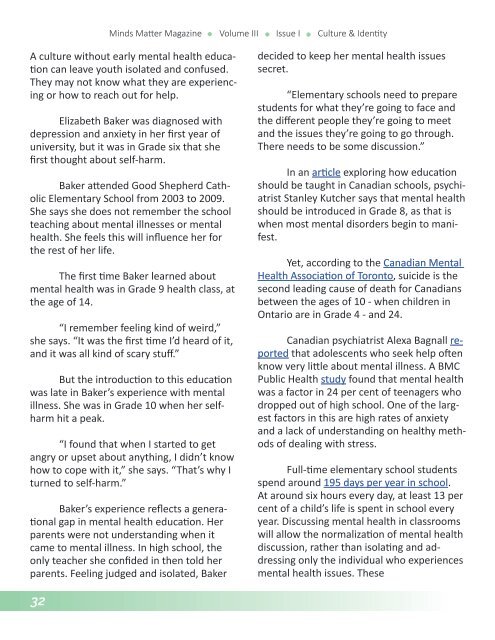Culture & Identity
Create successful ePaper yourself
Turn your PDF publications into a flip-book with our unique Google optimized e-Paper software.
Minds Matter Magazine Volume III Issue I <strong>Culture</strong> & <strong>Identity</strong> Minds Matter Magazine Volume III Issue I <strong>Culture</strong> & <strong>Identity</strong><br />
A culture without early mental health education<br />
can leave youth isolated and confused.<br />
They may not know what they are experiencing<br />
or how to reach out for help.<br />
Elizabeth Baker was diagnosed with<br />
depression and anxiety in her first year of<br />
university, but it was in Grade six that she<br />
first thought about self-harm.<br />
Baker attended Good Shepherd Catholic<br />
Elementary School from 2003 to 2009.<br />
She says she does not remember the school<br />
teaching about mental illnesses or mental<br />
health. She feels this will influence her for<br />
the rest of her life.<br />
The first time Baker learned about<br />
mental health was in Grade 9 health class, at<br />
the age of 14.<br />
“I remember feeling kind of weird,”<br />
she says. “It was the first time I’d heard of it,<br />
and it was all kind of scary stuff.”<br />
But the introduction to this education<br />
was late in Baker’s experience with mental<br />
illness. She was in Grade 10 when her selfharm<br />
hit a peak.<br />
“I found that when I started to get<br />
angry or upset about anything, I didn’t know<br />
how to cope with it,” she says. “That’s why I<br />
turned to self-harm.”<br />
Baker’s experience reflects a generational<br />
gap in mental health education. Her<br />
parents were not understanding when it<br />
came to mental illness. In high school, the<br />
only teacher she confided in then told her<br />
parents. Feeling judged and isolated, Baker<br />
decided to keep her mental health issues<br />
secret.<br />
“Elementary schools need to prepare<br />
students for what they’re going to face and<br />
the different people they’re going to meet<br />
and the issues they’re going to go through.<br />
There needs to be some discussion.”<br />
In an article exploring how education<br />
should be taught in Canadian schools, psychiatrist<br />
Stanley Kutcher says that mental health<br />
should be introduced in Grade 8, as that is<br />
when most mental disorders begin to manifest.<br />
Yet, according to the Canadian Mental<br />
Health Association of Toronto, suicide is the<br />
second leading cause of death for Canadians<br />
between the ages of 10 - when children in<br />
Ontario are in Grade 4 - and 24.<br />
Canadian psychiatrist Alexa Bagnall reported<br />
that adolescents who seek help often<br />
know very little about mental illness. A BMC<br />
Public Health study found that mental health<br />
was a factor in 24 per cent of teenagers who<br />
dropped out of high school. One of the largest<br />
factors in this are high rates of anxiety<br />
and a lack of understanding on healthy methods<br />
of dealing with stress.<br />
Full-time elementary school students<br />
spend around 195 days per year in school.<br />
At around six hours every day, at least 13 per<br />
cent of a child’s life is spent in school every<br />
year. Discussing mental health in classrooms<br />
will allow the normalization of mental health<br />
discussion, rather than isolating and addressing<br />
only the individual who experiences<br />
mental health issues. These<br />
students then grow to create a culture of<br />
adults that are educated and comfortable<br />
with mental health.<br />
School boards across Ontario are now<br />
realizing the importance of early mental<br />
health education. Ontario Shores has begun<br />
funding a curriculum in the Durham Region<br />
aimed at increasing awareness about mental<br />
illnesses. Their goal is to expand this curriculum<br />
across the rest of Ontario.<br />
In 2011, the Government of Ontario<br />
released Open Minds, Healthy Minds: Ontario’s<br />
Comprehensive Mental Health and<br />
Addictions Strategy, which introduced more<br />
mental health programming, tailored from<br />
childhood to old age. The implementation of<br />
their plan began with early intervention and<br />
support for children and youth in Ontario.<br />
It required school boards across Ontario to<br />
create specific mental health action plans.<br />
The Toronto District School Board<br />
(TDSB) created a 30-page five-year plan in<br />
2013, following a survey they had released<br />
the year before. In the survey, staff identified<br />
that a stronger approach to mental health<br />
was necessary for the students’ well being.<br />
Their plan aims to help educators recognize<br />
when students are experiencing distress and<br />
how to support them in their pathway to<br />
better mental health. It also gives suggestions<br />
on how to discuss mental health with<br />
parents and students at both the elementary<br />
and secondary level to maintain the support<br />
throughout education.<br />
The Durham District School Board<br />
(DDSB) released a 36-page five-year plan in<br />
2013. The plan was implemented in support<br />
of the board’s decisions to implement first<br />
aid in mental health, fight stigma, and establish<br />
a mental health committee by partnering<br />
with mental health organizations. By June<br />
2013, the school board planned for each<br />
elementary and secondary school to have<br />
at least one staff member trained in mental<br />
health first aid.<br />
But Baker’s elementary school, Good<br />
Shepherd Catholic Elementary School, is in<br />
the Durham Catholic District School Board.<br />
The school board’s action plan, released in<br />
2014, is only eight pages long with no lesson<br />
plans or outlines.<br />
Baker says if mental health had been<br />
addressed earlier, she “would like to think<br />
maybe things would have been different.”<br />
32<br />
33






